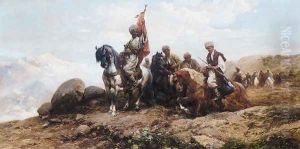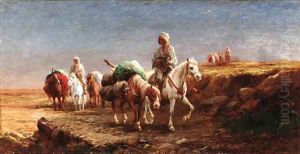Michal Gorstkin Wywiorski Paintings
Michal Gorstkin Wywiorski was a Polish painter and representative of the realism and symbolism movements in art, known primarily for his landscape and genre paintings. He was born on October 17, 1861, in the village of Wywórka in what was then the Russian Empire and is now Ukraine. Coming from a family with a noble lineage, Wywiorski received his initial education in art at the Drawing Class in Kremenchuk and later, in 1880, he continued his studies at the Imperial Academy of Arts in Saint Petersburg. During his time at the Academy, he was influenced by the works of Russian realists and learned the importance of capturing the essence of nature and everyday life.
Wywiorski's artistic development was marked by his travels across Russia and Europe, where he absorbed various artistic styles and techniques. After completing his education in 1885, he returned to his homeland, then partitioned by the Russian Empire, and settled in Warsaw. His works from this period often depicted rural life in Poland, showcasing the simple beauty of the countryside and the lives of peasants. He exhibited his paintings in Warsaw, Krakow, and abroad, gaining recognition for his contribution to Polish art.
As an artist, Wywiorski was also influenced by the symbolism movement, which emphasized the spiritual and emotional aspects of art. His landscapes often evoked a sense of mood and atmosphere, with an attention to light and color that added a lyrical quality to his work. Despite the realistic portrayal of subjects, his paintings often carried a deeper, symbolic meaning, reflecting his personal contemplation and the socio-political context of his times.
Wywiorski was a member of various artistic societies and contributed to the development of the art community in Poland. His dedication to art was not limited to painting; he was involved in art education and was a respected art critic. Michal Gorstkin Wywiorski passed away on June 21, 1926, in Warsaw. His works remain an important part of Polish cultural heritage and continue to be exhibited in museums and galleries, offering a window into the rural life of Poland and the artistic currents of the late 19th and early 20th centuries.

